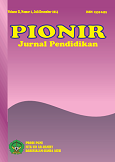HUBUNGAN KEMAMPUAN LITERASI SAINS DENGAN KEMAMPUAN LITERASI DIGITAL PESERTA DIDIK KELAS V SDN CENGKARENG BARAT 03 PAGI
DOI:
https://doi.org/10.22373/pjp.v12i3.20319Abstract
The purpose of this study was to analyze the relationship between scientific literacy skills and digital literacy skills of fifth grade students at SDN Cengkareng Barat 03 Pagi. The method used in this research is descriptive correlational with moment product correlation test. Researchers collected data through tests for scientific literacy and questionnaires for digital literacy. The results showed that out of 60 students, the highest score of Scientific Literacy was 90 and the lowest score was 65 with Minimum Completeness Criteria (KKM) of 75. The normality test shows that the significance value of scientific literacy and digital literacy is greater than 0.05 (0.200 > 0. 05, 0.200 > 0.05 and 0.132 > 0.05, 0.200 > 0.05). The result of the linearity test is that the significance value is greater than 0.05 (0.631 > 0.05). Based on the results of this study, it can be concluded that there is a relationship between scientific literacy skills and digital literacy abilities of fifth grade students at SDN Cengkareng Barat 03 Pagi in the high category with a value of r = 0.691.
References
Arikunto, S. (2018). Dasar-Dasar Evaluasi Pendidikan. Bumi Aksara.
Febliza, A., & Okatariani, O. (2020). Pengembangan Instrumen Literasi Digital Sekolah, Siswa Dan Guru. Jurnal Pendidikan Kimia Universitas Riau, 5(1), 1. https://doi.org/10.33578/jpk-unri.v5i1.7776
Huryah, F., Sumarmin, R., & Effendi, J. (2017). Analisis Capaian Literasi Sains Biologi Siswa Sma Kelas X Sekota Padang. Jurnal Eksakta Pendidikan (Jep), 1(2), 72. https://doi.org/10.24036/jep.v1i2.70
Kelana, J. B., & Pratama, D. F. (2019). Bahan Ajar IPA Berbasis Literasi Sains. In Lekkas (Issue Oktober).
Kurnianingsih, I., Rosini, R., & Ismayati, N. (2017). Upaya Peningkatan Kemampuan Literasi Digital Bagi Tenaga Perpustakaan Sekolah dan Guru di Wilayah Jakarta Pusat Melalui Pelatihan Literasi Informasi. Jurnal Pengabdian Kepada Masyarakat (Indonesian Journal of Community Engagement), 3(1), 61. https://doi.org/10.22146/jpkm.25370
Mijaya, N. P. A. P., Sudiatmika, A. A. I. A. R., & Selamet, K. (2019). Profil Literasi Sains Siswa Smp Melalui Model Pembelajaran Levels of Inquiry. Jurnal Pendidikan Dan Pembelajaran Sains Indonesia (JPPSI), 2(2), 161. https://doi.org/10.23887/jppsi.v2i2.19385
OECD. (2019). Programme for international student assessment (PISA) results from PISA 2018. Oecd, 1–10.
Pratiwi, N., & Pritanova, N. (2017). Pengaruh Literasi Digital Terhadap Psikologis Anak Dan Remaja. Semantik, 6(1), 11. https://doi.org/10.22460/semantik.v6i1.p11-24
Pratiwi, S. N., Cari, C., & Aminah, N. S. (2019). Pembelajaran IPA Abad 21 dengan Literasi Sains Siswa. Jurnal Materi Dan Pembelajaran Fisika, 9, 34–42.
Pujiati, A. (2019). Peningkatan Literasi Sains dengan Pembelajaran STEM Di Era Revolusi Industri 4.0. Universitas Indraprasta PGRI Jakarta INFO, 0812(80), 547–554.
Purwanto, M. N. (2020). Prinsip-prinsip dan Teknik Evaluasi Pengajaran. PT Remaja Rosdakarya.
Solichin, M. (2017). Analisis Daya Beda Soal, Taraf Kesukaran, Validitas Butir Tes, Interpretasi Hasil Tes Dan Validitas Ramalan Dalam Evaluasi Pendidikan. 2, 192–213.
Sutrisna, N. (2021). Analisis Kemampuan Literasi Sains Peserta Didik SMA di Kota Sungai Penuh. Jurnal Inovasi Penelitian, 1(12), 2683.
Syaripudin, A., Ahmad, D., Ningrum, D.W., Banyumurti, I., & Magdalena, M. (2017). Kerangka Literasi Digital Indonesia.
Syofyan, H., & Amir, T. L. (2019). Penerapan Literasi Sains dalam Pembelajaran IPA untuk Calon Guru SD. Journal Pendidikan Dasar, 10(2), 35–43.
Wahyuningsih, S. (2021). Literasi Sains Di Sekolah Dasar Jakarta 2021. Literasi Numerasi Di Sekolah Dasar.
Yasa, I. M. W., Wijaya, I., & ... (2022). The Implementation Profile of The Science Literacy Movement in Elementary Schools. Jurnal Ilmiah …, 6(2), 319–330. https://ejournal.undiksha.ac.id/index.php/JISD/article/view/45174
Downloads
Published
Issue
Section
License
- Authors retain copyright and grant the journal right of first publication with the work simultaneously licensed under a Creative Commons Attribution License that allows others to share the work with an acknowledgment of the work's authorship and initial publication in this journal.
- Authors are able to enter into separate, additional contractual arrangements for the non-exclusive distribution of the journal's published version of the work (e.g., post it to an institutional repository or publish it in a book), with an acknowledgment of its initial publication in this journal.
- Authors are permitted and encouraged to post their work online (e.g., in institutional repositories or on their website) prior to and during the submission process, as it can lead to productive exchanges, as well as earlier and greater citation of published work (See The Effect of Open Access).

